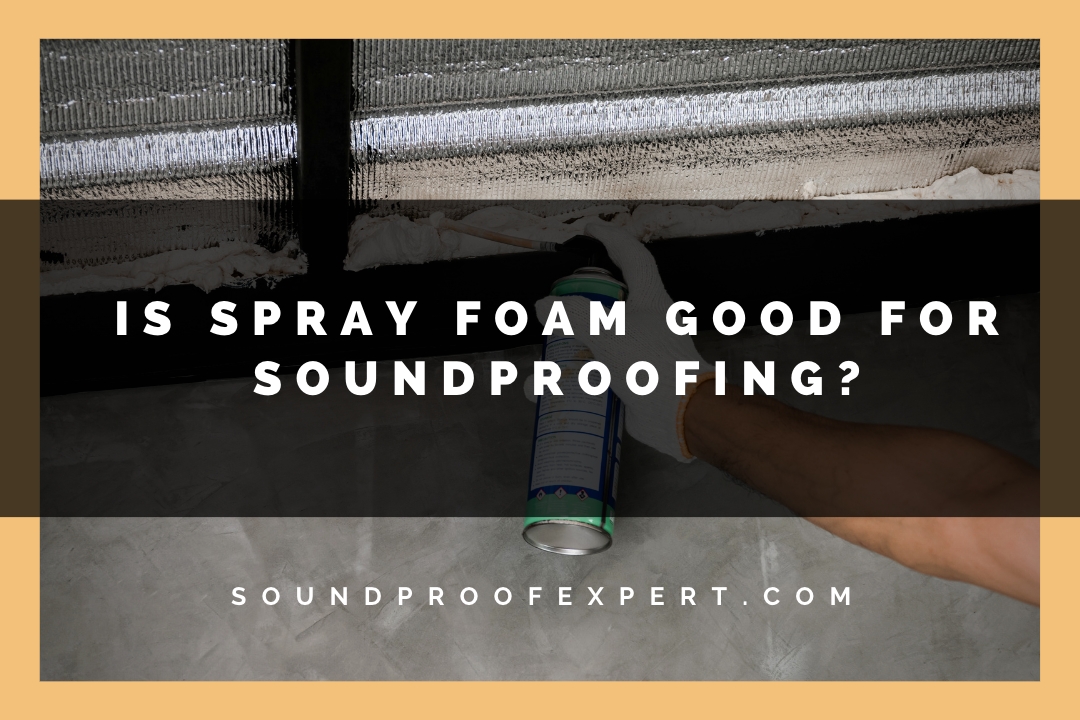
Unwanted noise can be irritating and should be dealt with to the best of your abilities.
You might’ve heard about spray foam as an insulator, but can you possibly use it for soundproofing?
Spray foam is good for soundproofing, but it won’t block out the highest noise levels. It can only reduce the amount of ambient noise that reaches your ears. Spray foam is not intended as a substitute for traditional soundproofing materials like acoustic panels.
In this article, we’ll talk about the noise-reduction capabilities of spray foam and discuss the most effective soundproofing materials. I’ll help you decide which spray foam you should get for your house and how to use it.
Spray Foam’s Noise Reduction Capabilities Examined

Spray foam is mainly used for insulation. It is used in the construction of walls, floors, ceilings, and around windows to keep heat in when it’s cold outside. At the same time, spray foam can reduce noise in your house.
The effectiveness of spray foam as a noise reduction material depends on the type and thickness of the insulation used and where it’s being applied.
The flexible nature of spray foam makes it capable of absorbing and deflecting sound waves when properly installed on walls or ceilings. Additionally, it provides a tight air seal between different rooms and floors, which can help reduce sound transmission from one space to another.
When evaluating the noise reduction properties of spray foam, you’ll find that it has excellent characteristics. If you’re interested in the insulation value of soundproofing materials, you should read this article about R-values.
When Should You Use Spray Foam?

Unwanted noise can considerably disturb those who simply want peace and quiet when sleeping, working, or relaxing. You can soundproof your room from outside noise or sounds from within your house. Soundproofing shouldn’t be expensive or complicated, and spray foam is an excellent option if you don’t want to spend a lot of money.
Spray foam isn’t challenging to work with; it can soundproof walls that have already been constructed. It can be a bit messy, but you’ll get the hang of it quickly.
However, spray foam isn’t the most effective option for soundproofing. I recommend it only if the noise you’re trying to keep out isn’t too loud. Spray foam won’t do much for extreme noise disturbances.
What is more effective than spray foam?
Spray foam is not the best choice for soundproofing. You can find more effective ways to soundproof rooms, some of which are more expensive than others. These are installed using different methods, which can take time and require precision to ensure they look good.
The most effective soundproofing materials are fiberglass and acoustic panels. Fiberglass has high-density properties that make it very effective at absorbing sound. Acoustic panels are known for their ability to reflect and diffuse incoming sound waves.
Fiberglass Soundproof Panels
Fiberglass works miracles for soundproofing and insulation. Some fiberglass soundproof panels have unique designs to transform your interior. They can become part of your decor and not just be used for their functionality.
Acoustic Panels
Acoustic panels can completely change the look of any room. They are made from polyurethane foam and are very efficient in noise reduction. The panels offer heat insulation, like fiberglass and foam spray. You can tape them to the wall with double-sided foam tape.
Acoustic panels can be very cheap, but the price range is broad, so some are expensive. Nevertheless, you pay for quality and looks, so it could be worth the investment.
I recommend the HPKL9999 Acoustic Panels on Amazon. The black wedge tiles have a neat look. They are made from environmentally friendly polyurethane foam and come in a 48-pack.
Can You Use Spray Foam After Home Construction?
Wall insulation is a vital part of any home construction project. During construction, the gap in the wall is usually filled with fiberglass or spray foam, sometimes combined.
If you want to soundproof a room after construction, you wouldn’t want to break down the existing wall only to rebuild it after. You can follow these steps instead:
- Drill tiny holes in the wall. The holes should be big enough for the spray foam nozzle to fit through.
- Fill the holes with spray foam. Fill the wall gaps using spray foam to soundproof your room and insulate it simultaneously.
- Cover the tiny holes in the wall using wall putty. Use a putty knife to fill any gaps and cracks. Don’t forget to use sandpaper to smooth it out after the putty has dried.
Wall putty is cheap, and you can easily find it in hardware stores and online stores. I recommend the Red Devil Lightweight Spackling from Amazon.com. It’s an affordable 8-ounce (227 grams) bucket with white putty. You can paint over the putty after it’s dried completely, and it won’t shrink after a while.
Which Insulation Foam Should You Get for Noise Reduction?
Many high-quality spray foams are available, and the price range is extensive. Always check reviews online because those will give you the most honest product descriptions.
I recommend the GREAT STUFF Insulating Foam Sealant on Amazon. It comes in an 8-pack of 12-ounce (355-milliliter) spray cans. The cans can fill gaps up to three inches (7.6 centimeters), and the foam sticks to wood, metal, glass, and plastics.
Final Thoughts
Spray foam is a good option for soundproofing if you don’t have much money to spend and the noise you’re trying to block isn’t too loud. It’s best used for insulation instead, as there are more superior materials used for soundproofing, like fiberglass.
It’s possible to soundproof existing walls with spray foam by drilling tiny holes and filling the wall gap. You can seal the small holes with wall putty after and make it look as good as new.
